In “Reaping the Rewards,” I take a look at the finished product from a crowdfunding campaign. Today’s topic: Santorini, a game of Greek gods and building towers. Santorini was funded on Kickstarter in April 2016 by Roxley Games, and delivered to backers by the beginning of 2017. It sold out at retail very quickly and was very hard to get; fortunately for those who missed the Kickstarter, Spin Master acquired the rights to produce a retail edition, which debuted at Gen Con and is in stores now.
What Is Santorini?
Santorini is an abstract strategy game for 2 to 4 players, ages 8 and up, and takes about 20 minutes to play. It retails for $29.99, and is now available in stores and from online retailers like Amazon. You may still be able to find some Kickstarter editions, which have a few additional components, but the gameplay is the same. The theme involves Greek gods and goddesses and is appropriate for kids but still challenging enough for adults.
Santorini is GeekDad Approved!
Santorini Components
The Spin Master edition includes:
- 1 Island board
- 1 Decorative Cliff base
- 22 Bottom Blocks
- 18 Middle blocks
- 14 Top Blocks
- 18 Domes
- 6 Worker pawns
- 30 God Cards

The Kickstarter edition also included an ocean board—the decorative cliff base rested on the ocean, and then the island board was placed on top of that, making the board look like the island depicted on the box cover. However, both the ocean board and the plastic cliff base are purely decorative and don’t actually affect gameplay. It’s a nice touch, and definitely looks impressive, but you don’t need it. The ocean base may be available separately in a later expansion.
Kickstarter backers also got a softcover picture book called Santorini: The First Game, a story about Aphrodite and Ares coming up with the idea to help mortals build their towers (and then tearing them down and starting over). It’s cute, and features more artwork like what you see on the cover, but isn’t necessary to play the game.
Finally, the Kickstarter also included the Golden Fleece expansion, which adds 15 more gods and 10 heroes, as well as a Golden Fleece pawn and a few other bits—this will potentially become available from Spin Master in the future, so I won’t get into it too much here.
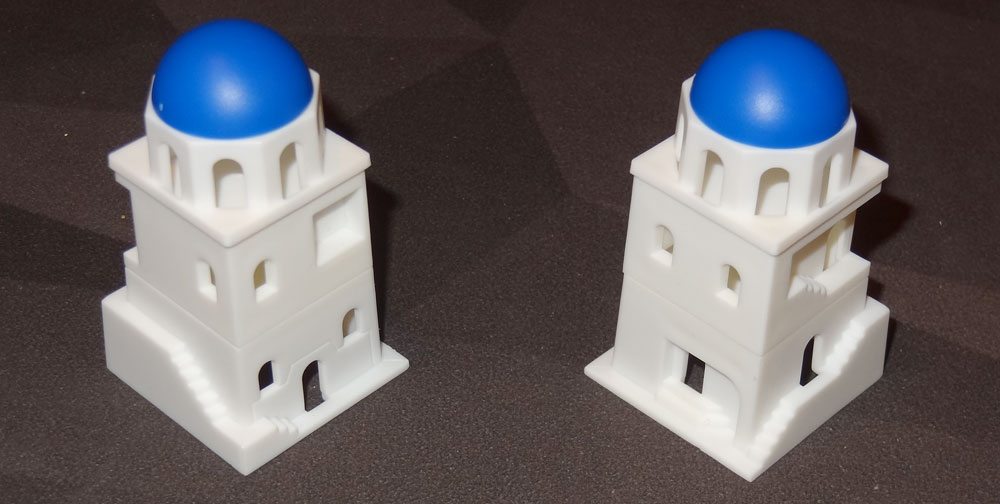
The components in the Kickstarter edition are top-notch. The buildings look really fantastic, and fit together very easily. The worker pawns are small plastic people, with two in each of three colors.

I haven’t seen the Spin Master version in person, but it looks to be very similar, though some of the plastic manufacturing might be a little lower quality from some photos and videos I’ve seen. The retail price is about half that of the Kickstarter, and I’m not sure if removing the ocean board and Golden Fleece expansion was enough. Even so, the games look extremely similar at a glance.

How to Play Santorini
The rules say that Santorini is best as a 2-player game, but there are rules for playing with 3 or 4 players. I’ll describe the 2-player game, and then mention the slight adjustments for more players.
The Goal
The object of the game is to move one of your workers up to the third level of a building, or trap your opponent so they’re unable to make a move.
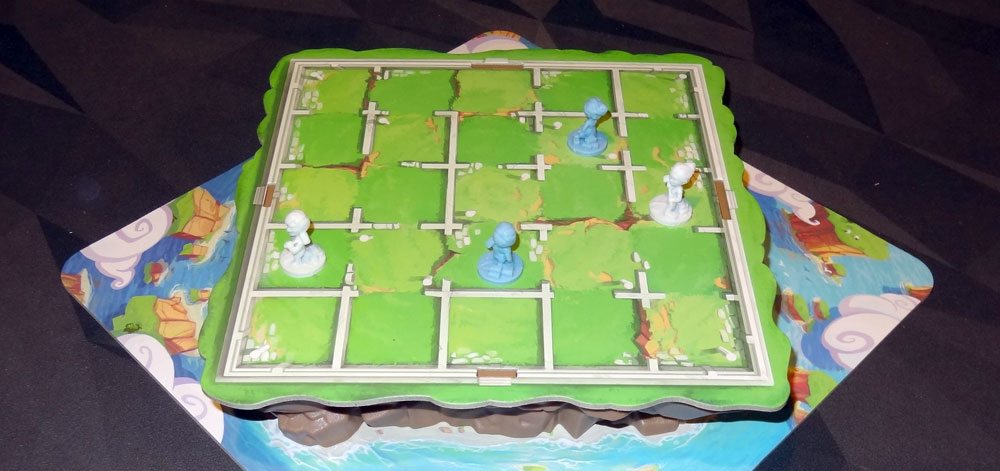
Setup
Setup is pretty simple: put the island board on the cliffs. (Or don’t, if you want to just use the board itself.) The starting player places their two workers anywhere on the board, and then the second player places their workers on the board.
Gameplay
On your turn, you must move and then build.
Move: Move one of your two workers one space in any direction (including diagonally). They may move up one level higher or move down any number of levels, or stay at the same level. You may not move into a space that has either another worker or a dome.
Build: Place a block or dome on an unoccupied space next to the worker that just moved (including diagonally). You may build at any height, but you must use the right piece: base, middle, top, and then a dome.
If one of your workers is able to move up onto a top piece (without a dome), then you win!
If you are ever unable to move and then build, you lose!
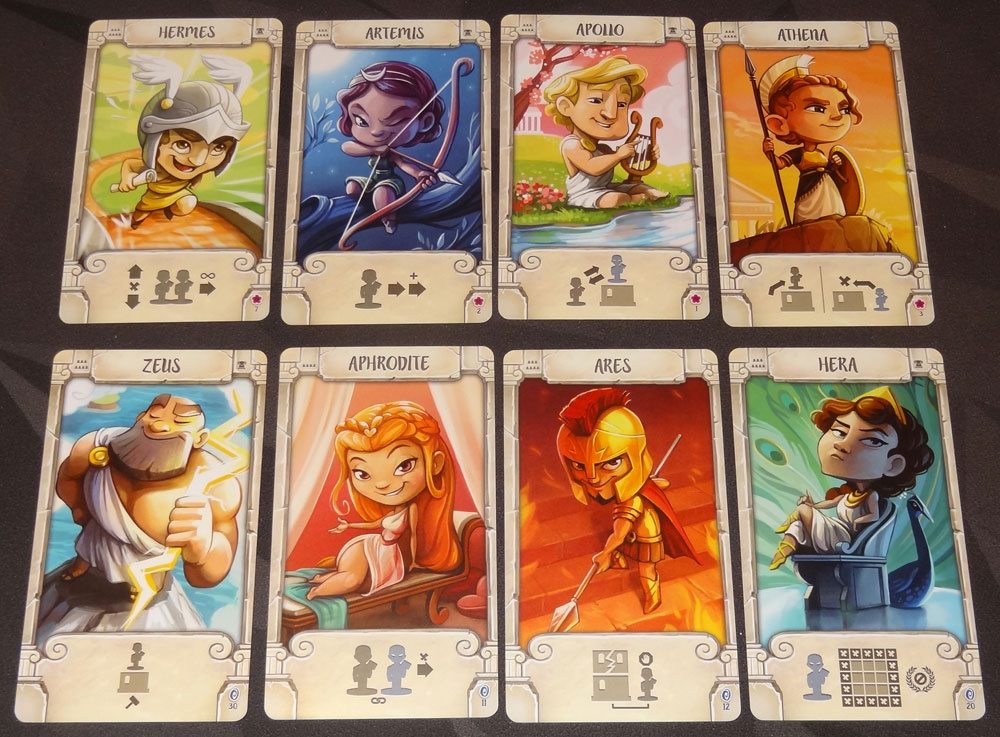
God Powers
Once you’ve gotten a grasp of the base game described above, you can introduce the god powers. The gods are divided into 10 simple and 20 advanced gods.
To set up, one player (the “challenger”) gets to choose which god powers are in play (one per player), and then everyone in turn order chooses one of the god power to take (with the challenger picking last). Then the challenger gets to pick the starting player. It’s sort of an “I cut, you choose” so that the challenger will pick powers that are roughly equal in power. Some powers are marked with 3- or 4-player icons, so you should make sure to choose gods that are compatible with the number of players you have.
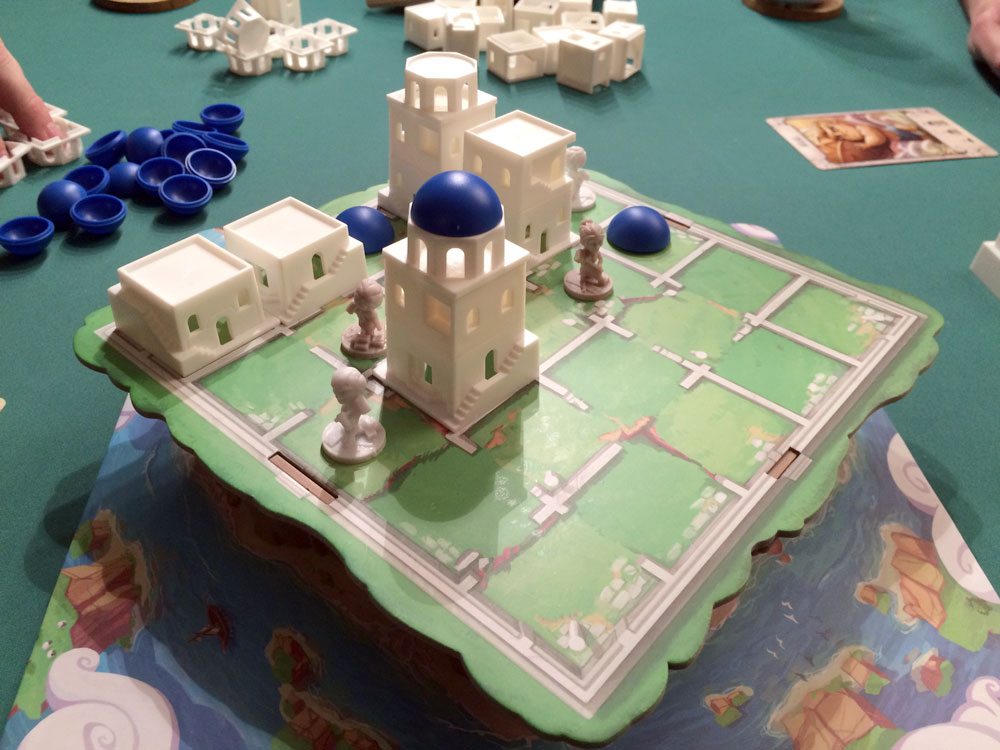
Each god card has some icons at the bottom that give you a reminder of the power, but the powers themselves are described in the rulebook. Some powers say “cannot” or “must” and you have to follow those instructions or you lose. Some powers are triggered by specific events or during particular times of the turn. A few have additional setup requirements, or extra win conditions.
Basically, if you use the powers, everyone has slightly different advantages and disadvantages, but the core gameplay remains the same. As you would expect, the advanced gods have more complicated powers.
3-Player Game
A 3-player game works much the same way, except that if you lose, you immediately remove your workers, along with any tokens that may have been played (related to your god power), and then the game continues with the other two players until somebody wins.
4-Player Game
In a 4-player game, the players are on teams of 2, sitting across from each other so that turn order alternates between teams. Each player has their own god power, and you may not use your teammate’s god power.
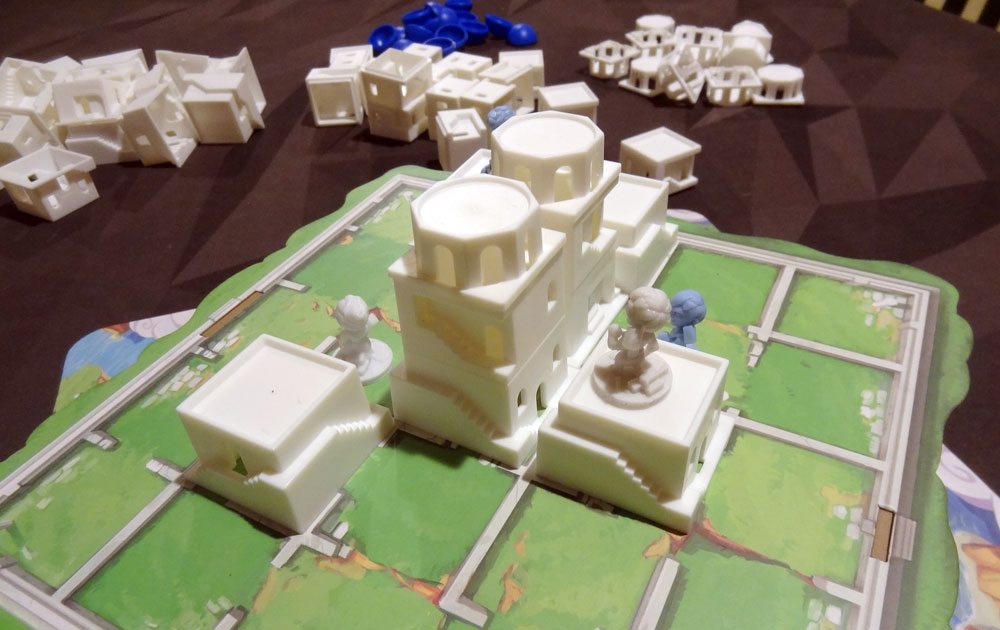
Why You Should Play Santorini
The tagline for the Santorini Kickstarter campaign was “Learn it in 30 seconds, play it for life!” and it’s easy to see why. The game really is easy to teach, with the basic rules fitting on just the front of the rulebook. It’s a simple concept: move and build. Even with just the basic rules and no god powers, the game is a great game of cat-and-mouse, as each player tries to get to a top level, but is also building up to prevent the other player from reaching it.
Since a worker can only climb up one level during a move, but you can build at any level, it’s common to have one of your builders down at ground level just making the towers too tall for the other player to climb. The catch, of course, is that then you’re also making them too tall for you to climb. Finding a place where you can build a step up but your opponent can’t reach the step is very tricky.
Once you introduce god powers, though, things can get really crazy. Pan can win if he moves a worker down two or more levels in one jump. Demeter lets a worker build twice (on two different spaces). Hermes can move both of his workers any number of spaces (including zero) if he doesn’t go up or down any levels. And those are just the simple gods. Advanced gods have powers that can remove blocks or even workers, or place restrictions on your opponents about where they may move or build. Zeus can build blocks underneath his workers, so you’ll have to be particularly vigilant to keep him from getting onto a top floor.
Santorini looks great on the table, and it’s quite satisfying to build up the buildings—they all just fit together really nicely, and the little windows and doorways and stairs really give it a fantastic appearance when you’re done playing the game. It’s the sort of game that you can play a couple times in a row, swapping out god powers to try out different combinations. I think it’s a fun idea to play a game, and then trade powers with the other player to see if the winner of the first game can out-think the power they just had.
I’ve tried playing the 4-player game with teams, and I really enjoyed it as well. It’s interesting to have two different powers to contend with, and trying to figure out how to use your own power to maximize your teammate’s ability. I haven’t played a lot of abstract strategy games that are team-based, so that felt new to me.
Despite the Greek gods theme, Santorini is still an abstract strategy game, so it’s going to appeal most to players who enjoy this sort of chess-like game. There’s no luck involved at all, and no hidden information—everything is right there on the board for everyone to see, so it’s a game of skill. Players who want to blame their losses on a bad draw or a lousy dice roll may not enjoy it quite as much. But if you enjoy abstract strategy games, Santorini really shines. I highly recommend giving it a try, and thanks to Spin Master, it should be fairly easy to find a copy now.
Click here to see all our tabletop game reviews.
Disclosure: GeekDad received a copy of this game for review purposes.

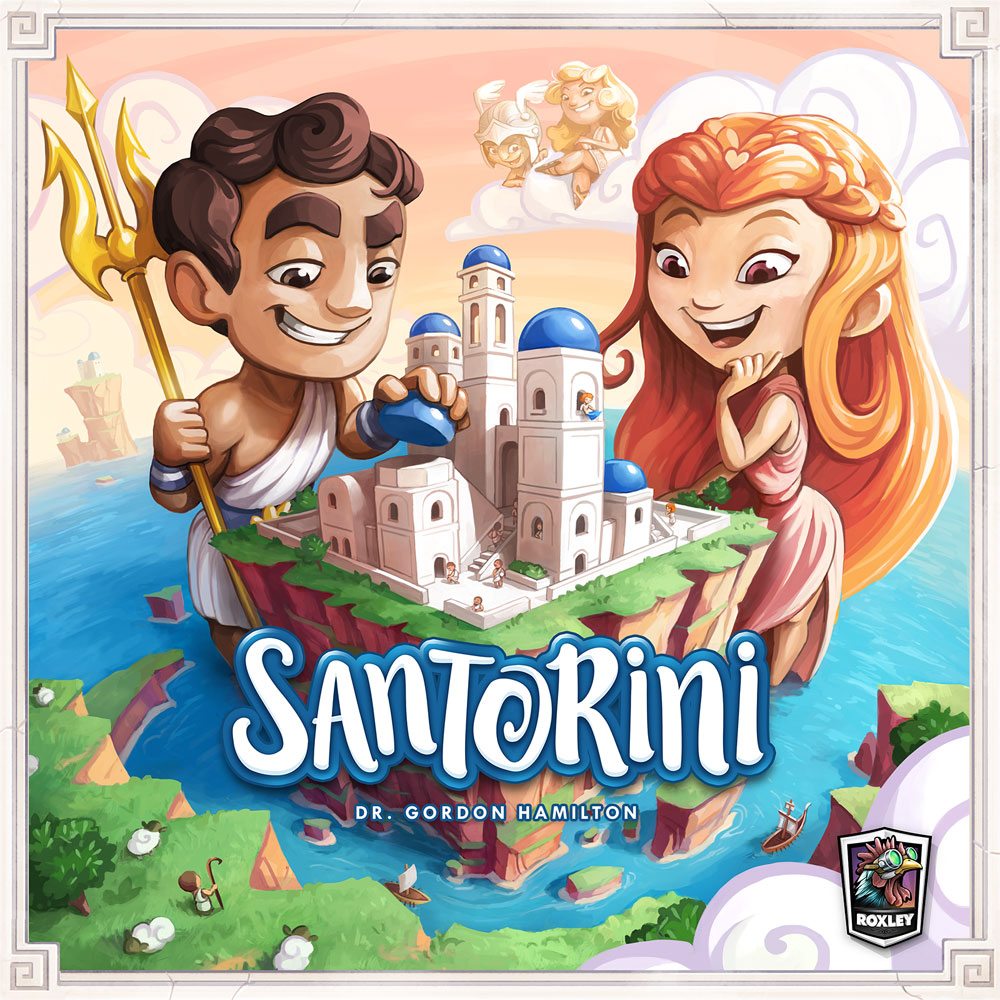
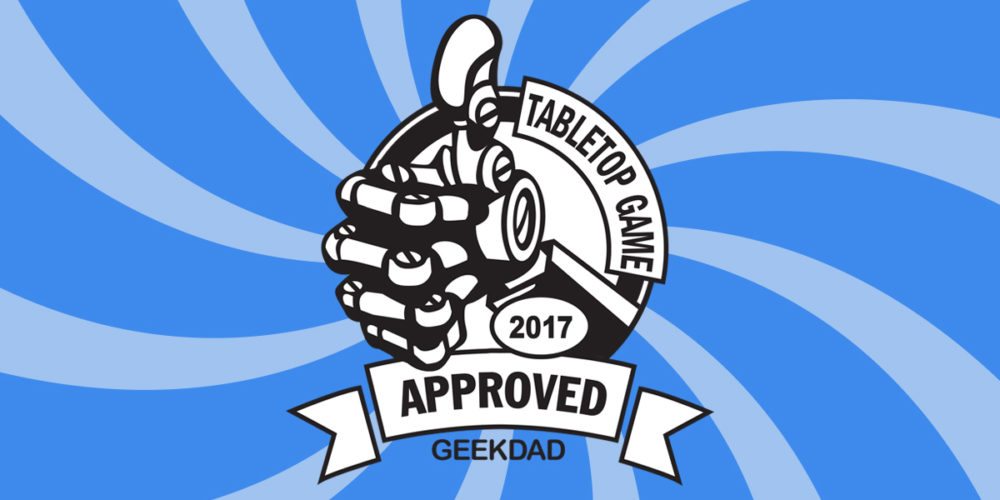





“The retail price is about half that of the Kickstarter, and I’m not sure if removing the ocean board and Golden Fleece expansion was enough.”
Enough for what?
I mean I didn’t know if removing the ocean board and Golden Fleece expansion is enough to account for the price difference. I would guess there’s some that comes from economies of scale, since Spin Master is probably producing a lot more of its version than Roxley did for the Kickstarter, but are those things combined enough for the price difference, or is the quality of the plastic a little lower, too? Unless I can see the two versions side-by-side to compare, I won’t know for sure.
Note on Zeus’s power: it is build underneath a worker but the win condition is to step up to level 3 so you can’t build under someone to win (but could elevate someone on level 1 that is next to a level 3 to set up for your next turn).
Yes—I specifically did not say that he could build his way to victory, but his ability to jump up onto a level 2 is something you have to watch out for.